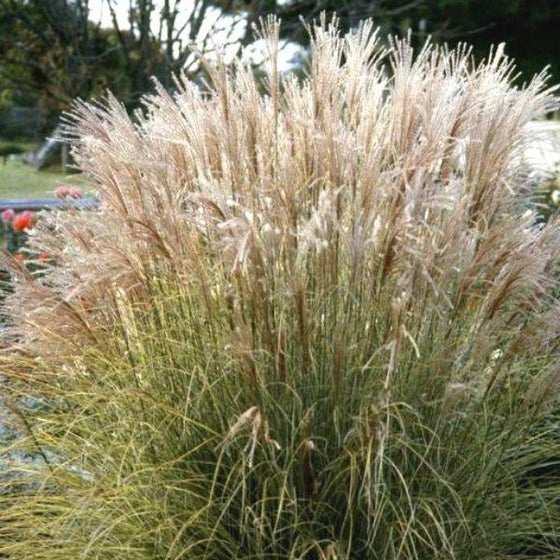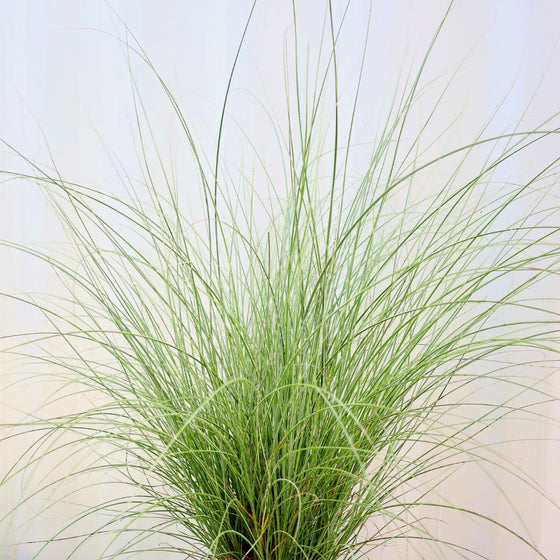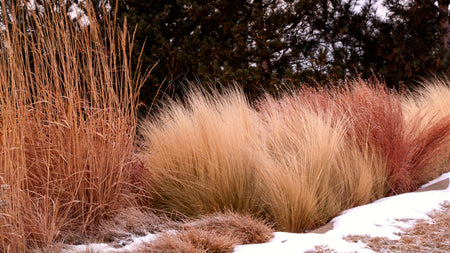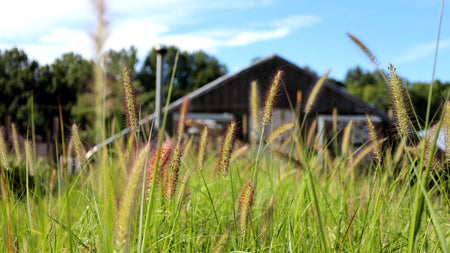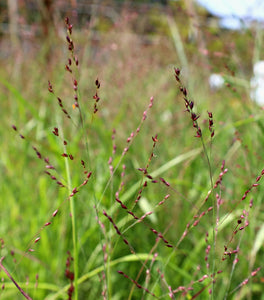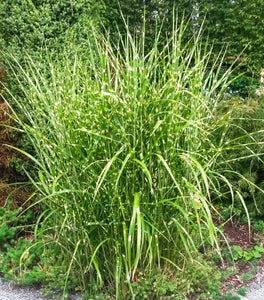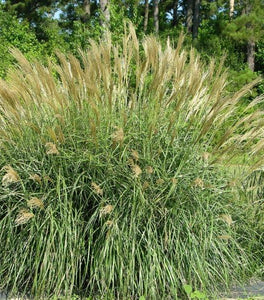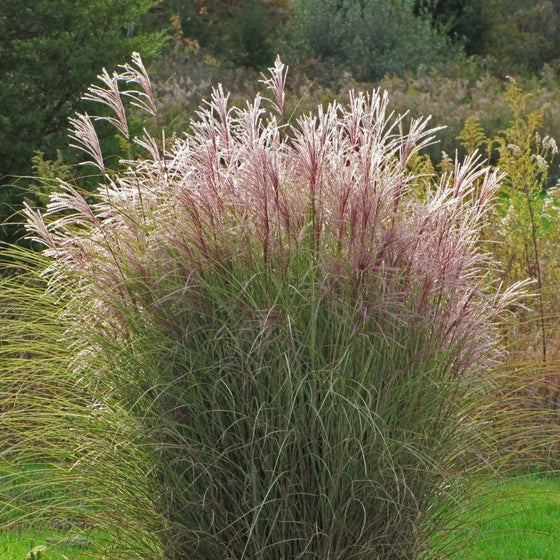
Images Depict Mature Plants
Miscanthus Morning Light for Sale Online
Miscanthus 'Morning Light' is an elegant, clump-forming ornamental grass known for its fine-textured, silver-green foliage that brings a soft, graceful appearance to any garden. This warm-season grass thrives in USDA Hardiness Zones 5-9, reaching a mature height of 4-6 feet with a spread of 3-4 feet. The narrow, variegated leaves, edged in white, give the plant a shimmering, airy look that catches the light beautifully, making it an excellent choice for adding texture and movement to your landscape. In late summer, 'Morning Light' produces delicate, reddish-bronze flower plumes that rise above the foliage, maturing to silvery white, adding even more visual appeal.
Miscanthus ' Morning Light ' offers year-round interest with its striking foliage and late-season blooms, ideal for use in mixed borders, as a specimen plant, or as a backdrop in garden beds. This grass thrives in full sun to partial shade and adapts to various soil types, including clay, loam, and sandy soils. It is also drought-tolerant once established, making it a low-maintenance option for both formal and naturalistic landscapes. The upright, arching growth habit adds vertical interest, while the airy texture softens the edges of hardscapes, such as patios or fences.
Miscanthus 'Morning Light' is also deer-resistant and provides excellent winter interest as its plumes and foliage remain standing through the colder months. In addition to its aesthetic value, it attracts birds that enjoy the seeds in late fall and winter, enhancing your garden's biodiversity. Whether used as a privacy screen, an accent in mixed plantings, or a focal point in a garden bed, Miscanthus 'Morning Light' offers versatility, elegance, and year-round beauty. Miscanthus Morning Light was bred to Be less invasive than other Miscanthus varieties.
Miscanthus 'Morning Light' adds a captivating sense of sound and movement to the winter garden with its delicate, silvery plumes and fine-textured foliage. As the wind gently sways the tall, arching blades, a soft rustling sound creates a soothing ambiance, bringing life and motion to an otherwise still landscape. Even in winter, when many plants have gone dormant, the dried plumes of 'Morning Light' catch the light and sway gracefully, providing dynamic interest. This ornamental grass not only enhances the visual appeal of the winter garden but also introduces an element of sound, transforming the garden into a peaceful, sensory-rich environment year-round.

| Hardiness Zone: | 5-9 |
|---|---|
| Mature Height: | 4 to 6 Feet |
| Mature Width: | 3 to 4 Feet |
| Sunlight: | Full Sun to Partial Sun |
| Water Requirements: | Dry to Moist |
| Selling Points: | Deer Resistant, Coastal Exposure, Urban Gardening |
How to Care for Miscanthus Morning Light
Before you buy Miscanthus Morning Light, be sure to read about the recommended care instructions to ensure your plant stays happy and healthy for years to come!
How Do I Plant Miscanthus Morning Light?
To plant Miscanthus 'Morning Light,' begin by selecting a location that offers full sun to partial shade, as this grass thrives in bright light but can tolerate some shade. It prefers well-drained soil, although it can adapt to various soil types, including clay, loam, and sandy soils. Start by loosening the soil to a depth of 12-18 inches, ensuring it is well-aerated. Dig a hole that is twice as wide and as deep as the root ball, and place the plant in the hole so the top of the root ball is level with the surrounding soil. Backfill the hole with soil, firm it gently around the base, and water thoroughly to help the plant settle in. Adding a layer of mulch around the base helps retain moisture and suppress weeds. When planting multiple Miscanthus 'Morning Light' grasses, space them about 3 to 4 feet apart to allow for their mature spread and upright growth. Water regularly during the first growing season to establish a strong root system. Once established, this ornamental grass is drought-tolerant, requiring minimal additional watering. It's important to plant it in an area with good drainage to prevent root rot, particularly in areas prone to heavy rainfall. Miscanthus 'Morning Light' is a low-maintenance choice that provides height, texture, and movement to garden beds, borders, or as a stunning specimen plant.
How Do I Water Miscanthus Morning Light?
Watering Miscanthus 'Morning Light' correctly is essential, especially during the first growing season, to help the plant establish strong roots. Initially, keep the soil consistently moist by watering deeply once or twice a week, depending on weather conditions and rainfall. The goal is to ensure that the top 2-3 inches of soil remain damp, but not waterlogged. Water at the base of the plant, and avoid overhead watering to reduce the risk of fungal issues. This deep watering method encourages root development, allowing the grass to better tolerate dry conditions once established. Mulching around the base can help retain moisture and reduce the need for frequent watering. Once Miscanthus 'Morning Light' is established, it becomes more drought-tolerant and requires less frequent watering. In most cases, rainfall will be sufficient to meet its moisture needs, especially in well-drained soil. However, during prolonged dry periods or extreme heat, it’s beneficial to water the plant occasionally to prevent stress and maintain its lush appearance. Be sure to check the soil moisture regularly during hot weather to keep the grass healthy and ensure its signature silver-green foliage and graceful plumes remain vibrant throughout the season. Proper watering not only promotes healthy growth but also enhances the plant’s drought-tolerant characteristics, making it a low-maintenance option for your landscape.
How Do I Fertilize Miscanthus Morning Light?
To fertilize Miscanthus 'Morning Light,' apply a balanced, slow-release fertilizer, such as a 10-10-10 formula, in early spring as new growth begins. Spread the fertilizer evenly around the base of the plant, but avoid placing it directly on the crown to prevent burning. After applying the fertilizer, water the area thoroughly to help the nutrients penetrate the soil and reach the roots. This spring feeding provides the essential nutrients Miscanthus 'Morning Light' needs to support its lush, silver-green foliage and graceful plumes throughout the growing season. For ongoing care, you can also amend the soil with organic matter, such as compost or well-rotted manure, to improve soil fertility and structure. Avoid over-fertilizing, as too much nitrogen can lead to excessive foliage growth and reduce flowering. Miscanthus 'Morning Light' is a low-maintenance grass that typically requires minimal feeding once established, but an annual spring application of fertilizer will ensure its continued health and vibrant appearance. With proper fertilization, this ornamental grass will thrive, adding height, texture, and beauty to your landscape.

How Do I Prune Miscanthus Morning Light?
Pruning Miscanthus 'Morning Light' is essential for maintaining its health and appearance. The best time to prune is in late winter or early spring, before new growth begins. Using clean, sharp pruning shears or hedge trimmers, cut the old foliage down to about 3-6 inches above the ground. This removes the dried leaves and plumes from the previous season, allowing fresh new growth to emerge. Be sure to wear gloves, as the leaves can be sharp. By cutting back the old growth, you promote air circulation and give the plant space to rejuvenate, ensuring it remains vibrant throughout the growing season. During the growing season, light pruning is generally not necessary, but you can remove any damaged or dead foliage as needed to keep the plant looking tidy. Avoid heavy pruning during the growing season, as it may disrupt the natural form and flowering of Miscanthus 'Morning Light.' Regular annual pruning keeps the plant from becoming too large and helps maintain its graceful, upright shape. Proper pruning ensures that this ornamental grass continues to provide texture, movement, and visual interest in your garden year after year.

